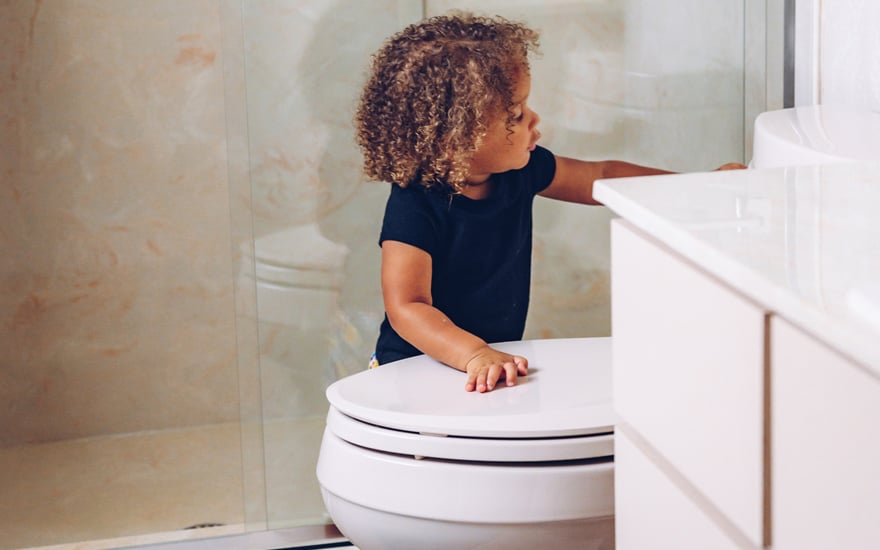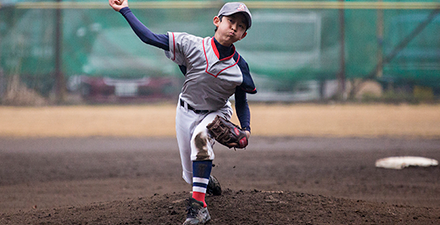
Toilet training or potty training is a developmental milestone for children and is one of the first steps to becoming more self-sufficient. However, it can be challenging for both children and their families. “Toilet learning” is not only about training to do the task, it’s also about motor learning to master continence. In other words, the child learns to perform a new skill, and, as they grow in capability, they become able to perform the skill over and over until they master it. Toilet learning is both a process and a continuum.
The following tips from a physical therapist can help your child succeed with learning toileting. These tips can also help them avoid future bowel and bladder problems.
1. Wait for it!
Starting to train too early can create frustration. It also can lead to poor toileting habits or the avoidance of toilet learning altogether. These habits can cause bowel and bladder problems such as urinary incontinence, bedwetting, urinary tract infections, and constipation.
However, even before a child displays signs that indicate they are ready to begin potty training, the learning process begins outside of the bathroom. These include teaching your child the kinds of tasks and steps that will be involved in “going to the bathroom,” such as getting to the bathroom, learning to sit on their own on a raised surface (not the toilet till they are ready), practicing breathing patterns, and helping your child dress or undress.
Bowel and bladder development and the beginnings of control start around the age of 18 months. At this stage, children begin to show signs or acts of readiness to toilet train, such as:
- Fidgeting, grunting, or pulling on their diaper.
- An interest or curiosity in toileting.
- The motor skills needed to safely sit on the toilet by themselves.
- The ability to pull down and up their clothes by themselves.
These signs of readiness begin to increase around 22 months (such as awareness of a wet or soiled diaper or the need to “go”).
The following questions can help you determine whether your child is ready for successful toilet training:
- Are they interested in and asking questions about toileting?
- Can they sense when they need to go?
- Can they get to and from the toilet area on their own?
- Can they get onto and off of the toilet (either a child-sized one or with assistance and a potty stool)?
- Can they help with dressing?
The potty training process takes three to six months on average. It can take less or more time, depending on a variety of factors. Starting too soon can make the process take longer. Typically, toilet training is completed by 4 years of age.
2. Expose for readiness.
A bathroom environment, especially a public one, can initially be an overwhelming sensory experience for a toddler. There are many sounds and smells (loud, wet, stinky, and cold). It’s important to talk through the experience when a child is with you for a toileting visit. For example, you can prompt by saying, “Remember, when we flush the toilet, it makes a loud whooshing sound, so get your ears ready!” and then, “As the swirly water takes the poop away, it also takes the yucky smell with it.”
It's important to help the child recognize what they may be feeling and what they can do about it. It helps if the caregiver talks out loud about “going.” For example, “Mommy had a big cup of coffee this morning, and now my bladder feels full. I think I need to go to the bathroom.” And then after going, “Ok, I feel much better. The pressure is gone!”
When a child shows awareness of bladder or bowel activity, allow them to spend some time at home without a diaper on. This will let them feel the air and freedom (and how nice it feels without a diaper). You can also talk to the child when a diaper is wet or soiled. Ask if they can feel the dampness or poop against their skin. Introduce books about what potty training is and what it feels like.
Invite the child to participate in toileting habits, starting with diaper changes. Let them hold the clean diaper or the wipe container while you talk about changing them into a clean or dry diaper. Explain how you are cleaning their skin so they’ll feel better and stay healthy. Allow them to flush the toilet for you, or lower the lid after you go. Help the child participate with you in hand washing after diaper changes, especially after they’ve helped you with the toilet.
3. Set up for success.
In the early phases, make sure a toilet is easily available. You can use a child-height, portable training toilet or let them experience being placed on a household toilet.
Potty position. A child’s position on the toilet is an important part of good practice. A child-height toilet is ideal, but a toilet seat reducer and a stepstool or footstool to properly support the size of the child’s bottom and the length of the child’s legs are also appropriate. An adult seat is too wide to support a child’s muscles for relaxing and emptying. Their legs also need to be positioned with the knees just above the hips. Dangling legs do not support toileting muscles. For a child with physical or cognitive differences, you may plan the fastest way to the toilet ahead of time to time their arrival for success.
Breathing. Complete emptying of the bladder or bowels requires the muscles to relax. Helping the child with breathing can reduce breath-holding and straining that tightens, rather than relaxes, muscles.
Dress for success. Children of toilet-learning age are just beginning to help their caregivers with dressing. Be mindful of their clothing during and after toilet learning. They may not have mastered buttons or zippers yet. Fabrics and clothing with elastics and flexibility that are easy to pull on and off can help avoid soiling clothes and help them feel that they “did it by themselves” to grow their confidence in doing it again and again.
Rewards for trying and success. Establish a reward system with routine tasks already happening during the day (like cleaning up). When toilet learning begins, offer rewards more often at first (like a small reward for each step: one for trying and one for success). Make rewards specific to toileting and give them immediately. Create positive experiences your child links with toilet learning, such as picking out their underwear, pull-up, or getting to change the toilet paper roll. Avoid negative reinforcement or punishment, as these can create anxiety in the child. Anxiety can lead to a tightening of muscles involved with emptying the bladder or bowels and create an inability to pass urine and stool.
Dietary do’s and don’ts. Many children struggle with urinary urgency, frequency, and constipation. These symptoms often relate to their diet. Avoid foods and beverages that are acidic or high in salt, sugar, caffeine, or carbonation. These can irritate the bladder and contribute to urgency and frequent urination. Make sure that your child gets enough water and fiber, which help with stool regularity and consistency. Softer stools are easier to pass and will decrease strain and constipation.
4. Practice new skills for mastery.
As the child learns to master toileting, they are also growing in age, skills, and independence. You can help them have success with new skills and other environments outside of the comfort of home.
Have fun with fasteners. More challenging fasteners (buttons, ties, and zippers) can increase the time it takes to make it to the toilet. Make sure to practice with new clothes during times when the child does not need to go. This can help to lower stress for learning opportunities. Also, expect some toileting errors and take them in stride as your child begins wearing clothes that are more challenging to fasten. And when they do soil something, remember, it’s not an "accident," but simply that the child’s clothes are wet or dirty, and that can be changed.
Plan for the environment. Distances to the toilet increase at schools and public locations. Make sure to talk about when you feel an urge to help your child understand when you and they need to head to the potty.
Adjust your reward strategy. As success becomes more consistent, reduce the frequency of rewards. Instead of a reward every time your child has a potty success, offer them “credit” for each success. At the end of a week, the credits (such as a sticker for each dry day) add up to earn a bigger reward, like an extra treat or fun activity over the weekend.
Expect progress — and setbacks. Remember: Every child experiences toilet learning differently. They may make progress one week and then have a few setbacks another week. Change or adapt your support, rewards, or environment for the child to continue their progress.
5. Establish a bedtime routine.
If bedwetting is an issue for your child, there are two important things to remember:
- Constipation is one of the leading contributors to bedwetting. See tip No. 3 for advice about maintaining a healthy diet.
- A proper bedtime routine allows the body to regulate other systems to ensure appropriate sleeping patterns. These tips can help:
- First, establish a bedtime and stick to it.
- Second, follow a pre-bedtime pattern that you and your child enjoy. For example, incorporate bathing or storytime into your child's routine.
- Avoid or limit fluids an hour before bedtime.
- Have the child make an effort to empty the bladder just before bed.
Help is out there!
Some children continue to have issues with urinary urgency, frequency, incontinence, infection, and constipation, even as they get older. These issues may be related to:
- Incomplete learning or toilet habits.
- A cognitive or physical hurdle that needs adaptation.
- A medical issue that a physician needs to explore.
If you are concerned that your child's bowel and bladder control is not where it should be for their age, talk with their pediatrician. They may refer you to another health professional. Some children can benefit from treatment by a pelvic floor physical therapist.
Physical therapists are movement experts who improve quality of life through hands-on care, patient education, and prescribed movement. You can contact a physical therapist directly for an evaluation. To search for a physical therapist in your area, visit Find a PT.


